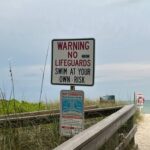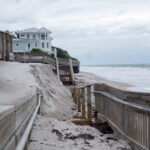From Vero Beach 32963
INDIAN RIVER COUNTY — Hundreds of thousands of cubic yards of beach-compatible sand have been dredged and are piled up west of Vero Beach, but it will take a bureaucratic miracle — and working seven days a week — to get the beach renourishment project done this season.
The county is relying on an ambitious timeline that assumes the various state and federal agencies will give their blessing to the project in record time, which would allow for completion by May 1 – the start of turtle nesting season. The situation is so tenuous that county commissioners and sand mine operators are asking barrier island residents with properties on precarious stretches of the 6.6-mile project to snap erosion photos and e-mail them to elected officials with pleas to help secure state and federal permits so the project can be done this year.
“That would hopefully make a difference, that’s the only thing that will get this project done this season within the time constraints of sea turtle nesting,” said Stephen Smith, co-owner of the Ranch Road Lake sand mine, which won the contract to renourish the beaches.
County Commissioner Bob Solari is not convinced that the updated timeline is based on the realities of the regulatory process.
“I definitely have significant concerns that there is a high probability that we can’t meet what the staff thinks is a reasonable schedule,” Solari said.
He plans to find out before the board meets again Nov. 3 so commissioners can make better decisions.
Among other things, the updated timeline assumes that Florida’s Department of Environmental Protection will only take 30 days to issue the permit, when they legally have 90 days to work on it. It assumes the same tight deadlines for other agencies who must also issue approval.
The past couple of weeks have been a rollercoaster ride for barrier island residents from Treasure Shores Park to John’s Island who have been waiting nearly a decade to get sand on their storm-weary shoreline.
Earlier this month, reports showed that the use of upland sand would, in time, cover up an offshore reef, so less sand would have to be used in the project. That would force the county to reduce by 26 percent – and in some parts as much as 88 percent — the amount of sand that could be placed on the beach.
The cold snap Vero Beach received on Oct. 17 brought erosion that took some three to six feet from the shoreline, making the call for immediate relief more urgent. With winter’s turbulent season coming up and some condominium buildings and homes perilously close to the edge at high tide, hundreds of millions of dollars in property could be at stake if there is more erosion.
If everything goes smoothly — even with Thanksgiving, Christmas and New Year’s holidays in the mix — permits may be issued the last week in February for a start date of about March 15, leaving 45 days to get nearly 500,000 cubic yards of sand on the beach by May 1.
This will require hauling about 600 truckloads of sand per day, possibly six or seven days per week.
On Monday, county staffers and engineering consultants met to redesign the project so every area can get its full complement of sand. The more coarse sand material will be strategically placed on the flat part of the beach, which is subject to the most wave action, and the less coarse sand will be used to stabilize the dunes, resulting in the full 472,000 cubic yards of sand being placed on the beach.
Rep. Ralph Poppell, who chairs the Natural Resources Appropriations Committee in the Florida’s House of Representatives, has pledged his support as has Sen. Joe Negron and Sen. Mike Haridopolos. Congressman Bill Posey’s office said he would work with the local officials to do anything he could to expedite the process.
(Editors Note: To read the complete version of this story go to our sister Web site, www.verobeach32963.com.)






